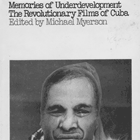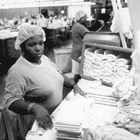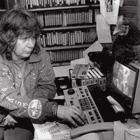The General Post Office Film Unit
An essay by Emmanuel Tsirigos. All rights reserved by Emmanuel Tsirigos.
In the 1930s a group of documentary films in Britain achieves national and international prestige. The well-known British documentary film movement made these film texts, most of them on behalf of the British government. Many critics believe that this body of films is Britain's greatest contribution to film theory and that John Grierson, the founder of the documentary movement, is 'the father of documentary'.
Grierson, a British intellectual, believed in the political role of the artist and emphasized social purpose through the creation of these documentary films. In 1928 he joined the Empire Marketing Board and organized its film unit. His first film, Drifters (1928), a documentary about North Sea herring fishermen was received enthusiastically in Britain and many considered it as a beginning of a new era in documentary film making. The representation of the working-class life and experience as 'heroic' was for Grierson a way leading to cultural and political reform.
The inter-war period in Britain was characterized by social and economic crisis. Unemployment figures were rising, particularly in the northern region, dividing the country and leading to poverty, exploitation and class struggle. Ideas coming from Eastern Europe were influencing a substantial part of the population and challenging the existing ideological and political consensus. Many artists and intellectuals were adopting political positions and started expressing their views in public. They were especially concerned with the life of the working classes and a number of them took part in documentaries produced by the film movement. The latter was part of a wider trend in British culture and used articles in the press, lectures or public appearances together with film in order to express political views.
The film market reflected the domination of the American commercial features. British films had to fight for a place on cinemas, especially the short films, which were facing the lack of legislative protection. Short films were being used mainly as fill-ups and they were eligible for quota only if they had entertaining character or increased public demand. In addition, exhibitors had prejudices against the educational or experimental films and especially the ones embodied government propaganda. In the meantime, the Labour government was trying to unify the nation and to iron out the dispute. Under these circumstances, the state followed the American developments of the Public Relations Industry and decided to use film to promote the public organizations and services. On the other hand, the state encouraged corporate capitalism and expansion. Thus, Grierson was appointed to make publicity films for the Empire Marketing Board and after its abolition he became the Film Officer of the General Post Office Film Unit. Grierson began expanding the unit by employing a number of talented film makers and young trainees.
An extensive body of literature concerning the films produced by the GPO film unit appeared and carried on until the seventies, eighties and nineties. Many critics have focused on the extent to which the films of the unit can be viewed as constituting a socially committed cinema. In order to assess this extent, I would like to divide this body of film texts in three parts, as they show a wide diversity of experimentation and a variety of approaches to documentary film making. These parts are the early production of the unit, the middle years of 1934 to 1937 and the period after Grierson's departure.
The transfer of the EMB to the GPO film unit was followed by the acquisition of larger premises and of an inferior British Visatone system for sound recording as well as the appointment of Alberto Cavalcanti (1934), whose contribution was enormous especially in the fields of sound and editing. The early production of the unit was confined in publicizing the Post Office services. These low-budget films were shot on location featuring 'real' people doing their jobs. Grierson used several silent film techniques coming from the contemporary Russian cinema and Eisenstain in particular. The early production of the unit included Cable Ship (1933) which was about the repairing of the submarine telephone cables by the Post Office, Weather Forecast (1934) on the collection of information on weather systems and Under the City (1934) on the maintenance of telephone cables. According to Paul Swan, "the image was ancillary to the sound track, whilst the narrator explained events to the viewer. The documentary group obtained sound recording equipment for the first time with the move to the Post Office. Consequently, they were experimenting and learning sound in the first years of the unit's life."
The approach to documentary filmmaking adopted by the movement in its early production was socially committed in the sense that the films intended to educate and inform the public. On the other hand, the people who appeared in the films were not speaking about themselves, but someone else was speaking for them. Under these circumstances they seemed distant. The only exception to this body of films was Six Thirty Collection where Harry Watt and Edgar Anstey tried to let the people participate in the voice-over narration. This experiment opened new ways in the movement's approach. Although the facilities for synchronized sound existed at that time, the unit was forced to use non-sync sound because of its cumbersome and inferior sound system.
The middle years of 1934 to 1937 were the unit's most productive and illustrated a variety of different approaches. At first there was a number of expensive and prestige films made for outside organizations featuring non-professional actors and receiving the quota registration for exhibition in commercial cinemas. The Song Of Ceylon (1934) by Basil Wright and John Taylor was commissioned by the Ceylon Tea Propaganda Board and contrasted a traditional way of life in Ceylon with the intrusion of the modern commercial culture. According to Ian Aitken, "Wright used associational editing devices which orchestrated sound and image formalistically to convey a sense of timeless tradition." The film was "showing an almost organic interconnection of social practices." The unit's most expensive film ever made (£7500) was BBC Voice of Britain commissioned by the BBC and included sequences of BBC's light entertainment programs. Although the film had a more commercial character than other GPO films, it was a box office failure. Although the social commitment of the expensive films was indirectly implied, as they were made to promote particular organizations, they introduced various cinematic techniques and contributed to film theory.
A group of films that appeared during the middle years of the GPO film unit introduced the direct location recording of speech, an element of substantial significance. Workers and Jobs (1935) was an expensive film commissioned by the Ministry of Information and featured unemployed men and officials at the Popular Labour exchange in London. Housing Problems (1935) by Elton and Astney was about slum clearance. It was an exceptional film in the sense that although the British Commercial Gas Association commissioned it, it did not have any immediate promotion of the product. Low R. writes that "Underprivileged people speaking freely for the first time in the midst of their dreadful environment, made a powerful impact very far removed from Grierson's heroic worker." On the other hand both these films retain a positive and optimistic view in the end. In Workers and Jobs the issue was depicted as totally resolvable and during the second part of Housing Problems we see the people installed in new flats. A number of critics have put the question of how a campaign for political and cultural reform can be combined with a hopeful and positive ending in such films, which conveys the sense that the best is being done.
The most interesting unity of films made during the middle years of the unit were usually shot on lower budgets than the films in previous categories and included a variety of experiments in dramatic construction and in the use of sound. Coal Face (1935) described the brutality of conditions experienced by the coal miners. Many critics believe that this is a Cavalcanti film and that Grierson replaced his name with his own in the titles. The film received a Medal of Honour at Brussels, because of its innovative techniques. Night Mail (1936) was about the collection and delivery of mail on a night train from London to Scotland. Aitken comments on this highly experimental film that "the poetry of W.H. Auden is used to add a symbolic dimension to a narrative on how Royal Mail binds society together through communication" Some commentaries have stressed the degree of identification with the working classes in this category of films. They argued that the landscapes of Coal Face were frightening, the miners looked distant or that the representation of the working classes was confined in men and that working class women were ignored.
The last category of films produced during the middle period of the GPO film unit includes abstract or whimsical experiments. This unity of films differentiates from the Griersonian tradition and it is not socially purposive. Len Lye's films Colour Box (1935) or Rainbow Dance (1936) evolved the technique of painting directly on celluloid. Love on the Wing (1937) by McLaren was a demonstration of animation techniques. Cavalcanti's Pett and Pott (1934) was about the usefulness of the phone and combined comic elements with fantasy. According to R. Low "the unit had flirted with fantasy. But from the time of Harry Watt's success with Bill Blewit onwards, the possibility of an alternative, more narrative approach to documentary was to play an important part in the movement." Unfortunately Aitken's comment about the films is that "although Grierson regarded these films as minor films, which they were, he encouraged and supported aesthetic experiment at the GPO film unit."
The late period of the GPO film unit begins with Grierson's departure. Many critics believe that there are several reasons which led him to take this decision like the replacement of Steven Tallents with Earnest Crutchney who was a traditional civil servant, the pressure the state exercised on Grierson to be confined in the Post Office services or the hostility of the film trade which argued that GPO's productions for outside organizations constituted unfair competition against it. R. Low writes about the difference of opinion within the GPO unit: "It is tempting to dramatize the split as a difference of opinion between Grierson, with his growing preference for the non-theatrical market and the film lecture and Cavalcanti, who because of his belief that a film should always be interesting and entertaining enough to get into the cinemas, was glad to encourage the narrative or dramatic documentary." The inclination towards the story documentary during the late period transformed the GPO film unit, which was departing from the Griersonian approach. North Sea (1938) made by Watt, was a characteristic example of this transformation. It was based on a reconstruction of a real event concerning the ship-to-shore radio service and featuring real deep-sea fishermen. According to P. Swann, "North Sea obtained more theatrical bookings than any other British documentary made in the 1930s." A number of commentaries on this film argued that the representation of the working classes was shallow because the characters were not speaking for themselves and had to follow the script and that the captain's character reflected authoritarianism. R. Low does not share this point of view arguing that "the stories were a viable alternative to the information film as a way of getting a message across."
Most of the documentary films produced by the GPO film unit reflected the political views and ideology of the documentary film movement. Under the government's film unit, the filmmakers found a space to experiment and develop the filmic language in order to express themselves in a stronger way. They were not facing the restrictions and limitations their colleagues were encountering within the film market. The political thought of the documentary movement and Grierson in particular, was opposed to laissez faire capitalism and leant towards a social-democratic consensus. According to Aitken "Grierson's political philosophy, particularly as reflected in his enthusiasm for the semi-independent public corporation, placed the documentary movement to the right of groups such as the Socialist League, who advocated extensive State ownership and to the left of groups such as the Keynesians, who advocated temporary State intervention in society and economy."The documentary movement featured the working class people as a way to prompt solutions to the existing social and economic crisis of the inter-war period. However the limitations on public expenditure, which seem reasonable, forced Grierson to look for non-governmental sponsorship for his documentaries. Having a close look at the GPO's film texts today, a feeling of political initiative is reflected. Grierson once stated that "They tell us that art is a mirror - a mirror held up to nature. I think this is a false image… In a society like ours, art is not a mirror but a hammer. It is a weapon in our hands to see and say what is right and good and beautiful, and hammer it out as the mould and pattern of men's action's." I think that the films of the unit act both as repositories and active creators of an ideological and political world.
In conclusion, I would like to question some specific matters concerning Grierson and the documentary film movement. Did Grierson achieve his purpose for political and cultural reform? Was the non-theatrical distribution system effective? Did the schoolchildren consolidate the messages of these films? Was it possible for the state in the face of an economic crisis to subsidize an extensive documentary film production? Maybe the answers to these questions will remain unresolved and will keep the critics busy for a long time.
Back to Theory






